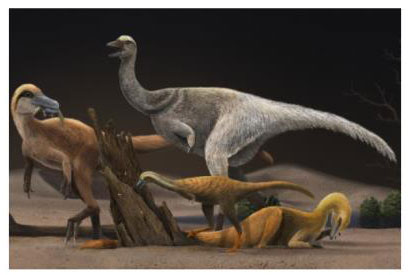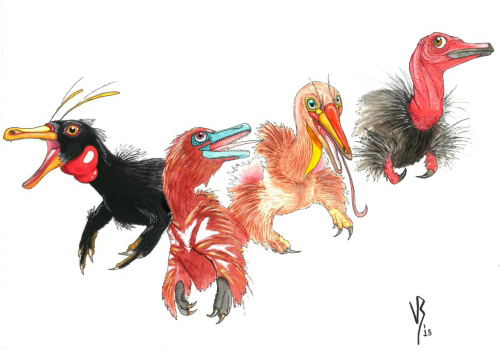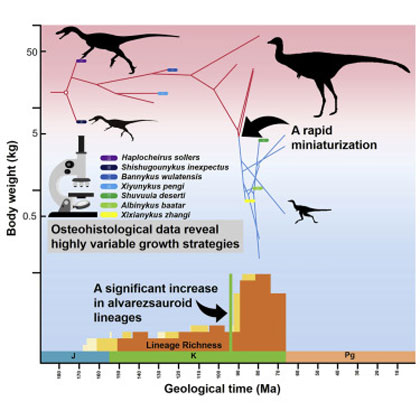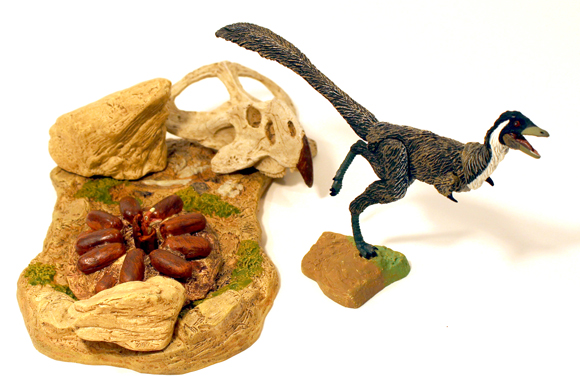Miniature Alvarezsauroids under the Spotlight
A new study into those bizarre theropods the alvarezsauroids, indicates that they became much smaller in the Late Cretaceous. Newly published research in “Current Biology” suggests that these dinosaurs reduced in size about 95 million years ago when they became specialised insectivores.
The research team, which included PhD student Zichuan Qin and Professor Michael Benton (Bristol University), along with researchers from the Chinese Academy of Sciences, George Washington University (USA) and Jonah N Choiniere from the University of Witwatersrand (South Africa), conclude that the miniaturisation of the alvarezsauroids probably coincided with adaptations to feeding on termites and ants. It has been a busy week for Professor Choiniere, as Everything Dinosaur recently published an article summarising a study of Heterodontosaurus that Professor Choiniere had co-authored: Breathing Life into the Dinosauria.

Miniaturisation in the Dinosauria is Very Rare
The research team define sustained miniaturisation within a group of animals as a drop in body size of at least two orders of magnitude from ancestors to descendants. This trait has been recorded many times in terrestrial vertebrates such as dwarf hippos and elephants, diminutive chameleons and tiny frogs. Miniaturisation is often associated with animals living in environments with limited resources such as islands and as such dwarf forms of dinosaurs associated with “island dwarfism” are known. However, in general terms miniaturisation within the Dinosauria is rare.
Miniaturisation is recorded twice within the Dinosauria:
- Once in the avialan theropods as powered flight evolved (the lineage leading to birds).
- Once in the Alvarezsauroidea -a bizarre group of dinosaurs nested within the Maniraptora.

Measuring Alvarezsaurs and Calculating their Age
The scientists measured the fossilised remains of dozens of these dinosaurs and assessed bone histology to separate juvenile, not fully grown specimens from adult fossil remains. They demonstrated that alvarezsaurs ranged in size from about 10 kilograms up to 70 kilograms for most of their evolutionary history, but from about 95 million years ago, very much smaller, chicken-sized forms, weighing less than 5 kilograms evolved. This miniaturisation coincided with these dinosaurs adopting a more specialised diet, that of consuming ants and termites.

Professor Michael Benton commented:
“Perhaps competition with other dinosaurs intensified through the Cretaceous. The Cretaceous was a time of rapidly evolving ecosystems and the biggest change was the gradual takeover by flowering plants. Flowering plants changed the nature of the landscape completely, and yet dinosaurs mostly did not feed on these new plants. But they led to an explosion of new types of insects, including ants and termites”.
The Cretaceous Terrestrial Revolution
The rapid evolution of flowering plants (angiosperms), led to a dramatic change in ecosystems with modern-looking woodlands and forests evolving with a diverse flora and fauna, including an enormous increase in insects that specialised on feeding on the leaves, nectar, petals and pollen of the flowering plants. This restructuring of ecosystems has been called the Cretaceous Terrestrial Revolution.
Whilst most other types of dinosaurs got bigger as they evolved, the alvarezsaurs seem to be the exception. When the first of these bizarre theropods evolved some of them were ostrich-sized, such as Haplocheirus, with sharp teeth and strong, flexible forelimbs suggesting a mixed and varied diet. However, from about 95 million years ago, body size plummeted and claw shapes changed from grabbing and tearing types to more robust forms. Arms became reduced as did the number of digits.
Mononykus (M. olecranus) typifies the Late Cretaceous alvarezsaurids. It roamed southern Mongolia around 70 million years ago and it measured about a metre in length and weighed around 3.5 kilograms. The forelimbs of Mononykus were tiny and they terminated in a hand that had just one digit topped with a very robust probe-like claw. This claw seems ideally suited to punching holes in termite mounds.

The image (above) shows the Beasts of the Mesozoic Desert set which features Mononykus.
To view the Beasts of the Mesozoic range of prehistoric animal models: Beasts of the Mesozoic Models.
The Second Case of Miniaturisation within the Dinosauria
Whilst most scientists accept the link between getting smaller and the evolution of powered flight within the branch of the Dinosauria leading to the evolution of birds, not much research had been undertaken into alvarezsauroid miniaturisation.
Professor Xing Xu (Chinese Academy of Sciences), a co-author of the study added:
“This is a very strange result, but it seems to be true. All other dinosaurs were getting bigger and bigger, but one group of flesh-eaters miniaturised and this was associated with living in trees and flying. They eventually became birds. We’ve identified a second miniaturisation event – but it wasn’t for flight, but to accommodate a completely new diet, switching from flesh to termites.”
The scientific paper: “Growth and miniaturization among alvarezsauroid dinosaurs” by Zichuan Qin, Qi Zhao, Jonah N. Choiniere, James M. Clark, Michael J. Benton and Xing Xu published in Current Biology.
The Everything Dinosaur website: Dinosaur Toys and Figures.

